結局何を持って「本物の刀」というかよくわからない人たち(=全ての人たち)に向けて書く。ここで、今一度、古今東西いろいろ言われている全ての要素を統合し、我々が「本物の刀」を定義し直す、というスタンスで書くこと
In 2015, a research team from the University of Tokyo presented experimental results on the performance of real Katana.
In terms of cutting force, the Japanese sword produced astounding results. The real Japanese Katana cut bamboo with a force of more than 200 N per square millimeter. This is more than three times the cutting force of a high-performance kitchen knife made with modern technology.
The results for durability were even more frightening: after 100 tough cutting tests, the sharpness of the kitchen knife dropped to less than 50%, while the Japanese sword retained 95% of its initial sharpness.
Furthermore, electron microscopy revealed that Real Katana cut surfaces were smooth with an average roughness of less than 0.1 μm. This is 5-10 times smoother than the surface cut by a kitchen knife (average roughness 0.5-1μm). The object cut by a Japanese sword is beautifully split in half.

What is surprising is the fact that such weapons were created so long ago, and that it is virtually impossible with modern technology to reproduce something similar. There are numerous mysteries surrounding the Japanese sword, which is why we handle this product.
Although there are many Katana-related products available today, there are actually not many Real Katanas with this kind of appeal.
Here we will explain the basic elements that make up a Katana, what makes a Katana Real, and what exactly is the “Real Antique Katana” that we deal in.
ここに目次ドカン
1. 刀 -What is Katana?-
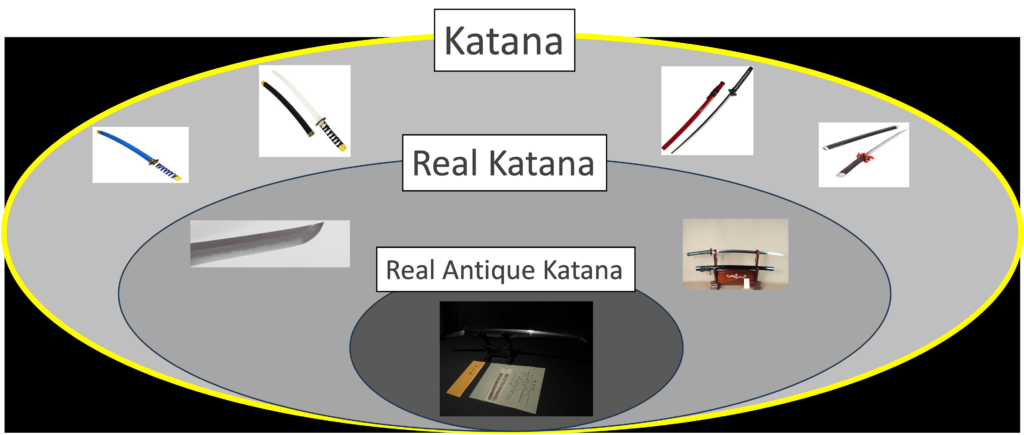
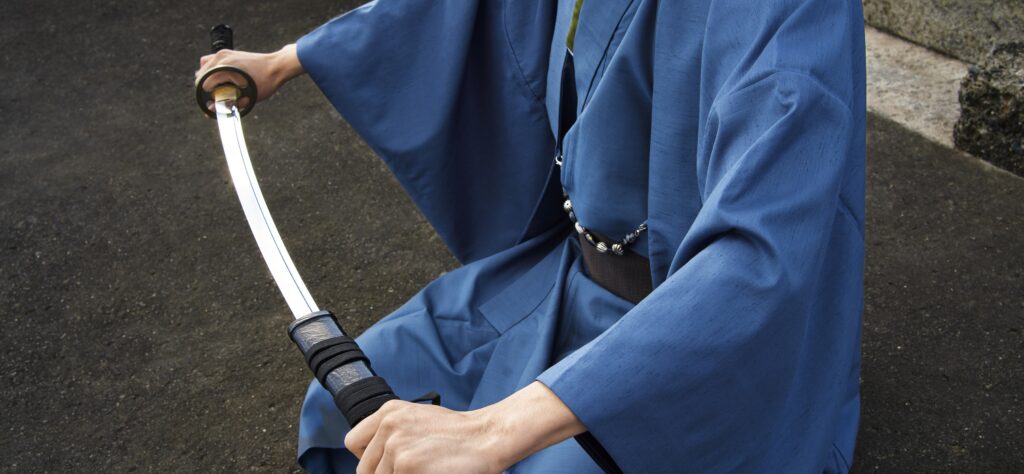
刀を定義するもの -What defines Katana-
While the definition of the Katana varies from person to person, the feature that most distinguishes it from other weapons is its shape.
Unlike swords used in many other countries, which are straight with blades on both sides, the Japanese Katana has a curved shape with a blade on only one side.

The length shown in the figure above is called the “Sori”. This is a measure of the curvature of the Katana and is the key to its iconic beauty.
Katana is able to cut objects effectively with less force because of this sori. Straight lines are more effective for thrusting movements, and this shows that Katana is made specifically for slashing objects in half.
武器としての刀 -Katana as a weapon-
The history of sword making in Japan dates back to B.C., when straight swords were initially brought from mainland China.
It is believed that curved swords with Sori appeared after the Jouhei-Tengyo wars of 935 during the mid-Heian period (794-1185). This is due to the fact that “Samurai” began to rise around this time.
They were a group that made their living fighting with katana, and they served their masters, the Imperial Court and the Shogunate, with their military prowess.
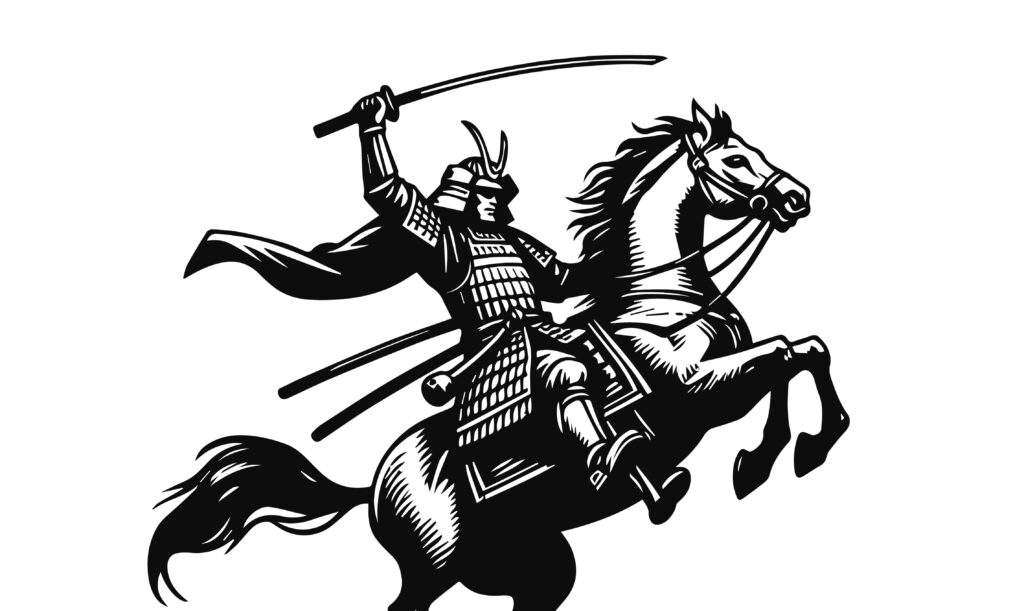
For the samurai, who basically fought on horseback, the curved sword had a structure that made the most sense. With this curvature, the sword could be drawn quickly in an arc on horseback and used for slashing in the same motion.
This also worked well in quick defense against enemy attacks. Samurais would quickly pull out their Katana on horseback, and then begin fighting without a moment’s pause.
The era moved on to the Kamakura(1185-1333), Nanbokucho(1333-1392), Muromachi(1336-1573), Azuchi-Momoyama(1573-1603), and Edo periods(1603-1868). During all these periods, the Katana has always served as a weapon of the Samurai.

In any age, what is required of a katana as a weapon is its sharpness.
In the Edo period (1603-1867), Yamada Asaemon Yoshimutsu, whose job was to cut heads for execution, tested Japanese swords on the bodies of criminals and rated them as Wazaamono(業物) if they had excellent sharpness.
In order to be called Wazamono, a sword had to be able to make 3 or 4 sharp cuts out of 10 attempts. Katana that were able to cut “greatly” seven or eight times out of 10 attempts were named Saijo-Owazamono(最上大業物).
Katana has been continually transformed by the legendary swordsmiths of each era. It has branched out into various schools and evolved into a wide variety of styles.
象徴としての刀 -Katana as a Symbol-
During the long period mentioned above (935-1868), the Katana has existed as a weapon of the Samurai, but also as a symbol in many different ways.
<写真>
First, the Katana is a symbol of the sacred in Japan.
Since ancient times, due to its strong trustworthiness as a weapon and its mystical beauty, it has been believed that the Katana is possessed by a deity and is dedicated to the Gods and Buddha.
These are called Honoto(奉納刀, votive swords), and because they are created for the purpose of pleasing the gods, giant Katana over 3 meters in length were sometimes created.
Also, there is a history of 1,000 beautiful Honotos being dedicated to a single shrine at the behest of the Emperor.
<写真>
Second, the Katana was a symbol of spirituality.
In Japan, there is a famous saying, “Katana is the spirit of the samurai”. This is an idiom meaning that the Japanese sword is so important to a samurai that his spirit resides in it.
A good Katana can cut an object in half with one straight swing. Samurai believed that humans, like katana, must be straight with their beliefs. This is the spirit of Bushido.
<写真>
As well as being a symbol of spirituality, the Katana was also a symbol of the samurai’s authority.
Samurai who found their identity in Katana became more concerned with it than with anything else.
The higher-ranking Samurais wore Katana made by famous swordsmiths, along with gorgeous Koshirae, and this was all about their status.
<写真>
In the modern era, as the Katana’s unusually high cutting ability and its otherness became known throughout the world, it became a cultural symbol of Japan.
The fierce way of life of the samurai and the spirit of bushido, the stubborn adherence to one’s beliefs, have also become widely known.
Numerous films and cartoons were produced based on Samurai and Katana motifs, and these transcended national borders. This is a great pleasure for us Japanese.
美術品としての刀 -Katana as an Artwork-
After the end of the Edo period, the Japanese sword was no longer used in actual battles due to the evolution of guns, cannons, and other firearms.
Then, after the Meiji Restoration, the “Sword Abolition Ordinance” was issued, prohibiting all but police and military officials from wearing swords. In this case, Japanese swords were not taken away from the townspeople and samurai families, but were kept in each family as heirlooms handed down from generation to generation.
The real Katana crisis came after World War II, when GHQ(The institution that occupied Japan) announced that Japanese swords and other weapons would be confiscated from private homes.
However, the Japanese government claimed that the confiscation of Katana was a robbery of cultural property, and as a result, only Japanese swords with artistic value were exempted from the confiscation.
The old Katana that survived this process are the “Real Antique Katana”, described below.
刀に似せた商品の値段 -Prices for Real Katana look-alike items-
There are now a variety of Katana-related products, including custom-made original swords and very inexpensive Real Katana look-alike products.
<写真>
A metal product in the shape of a Japanese sword that is not a real Katana is collectively called a Mozoto(模造刀) in Japan.
Instead of using Tamahagane steel (to be explained later) as the blade material, Mozoto swords are made mainly from aluminum alloys such as zinc, wood, and plastic. There are many vendors who sell such Mozoto as Real Katana, but beware, it is not true.
Since genuine Katana are limited in quantity and expensive, the demand for Mozoto as an inexpensive product has been increasing in recent years. Products that allow customization in terms of color and design are popular, and foreign manufacturers also sell these products.
Mozoto’s typical price ranges from 15,000 yen to 50,000 yen ($100 to $330), and they are purchased by light users who want to easily display a Katana-like figurine.
2. 本物の刀 ーWhat is Real Katana?ー
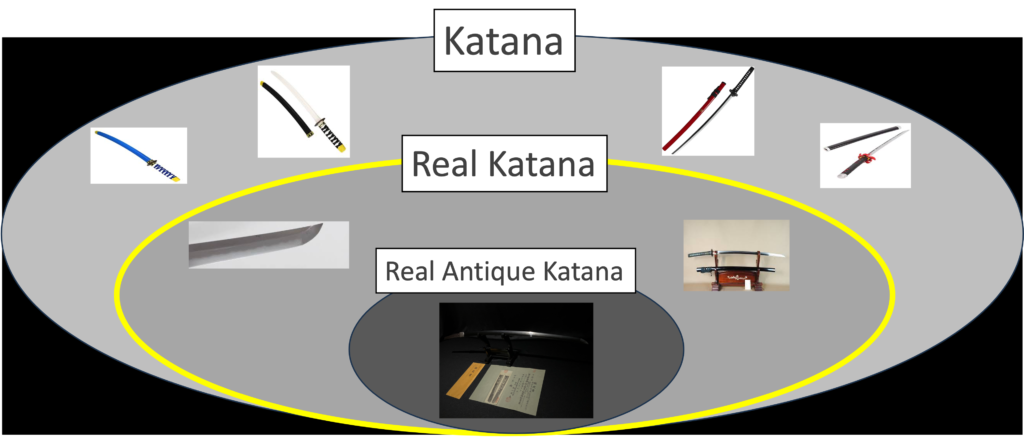

本物の刀を定義するもの -What defines Real Katana-
The Japanese Agency for Cultural Affairs(文化庁) has a clear definition of Real Katana(Nihonto). It is defined by material and manufacturing method.
“Real Katana(Nihonto) is Katana whose blades are made of high quality Tamahagane steel, crafted by traditional methods, and do not bend or break when subjected to strong impacts.” This is the definition set by the government.
However, experts dealing with Katana in Japan tend to refer to Real Katana only if it meets these plus a few other conditions.
In this chapter, we will go further and explain the conditions for Real Katana according to the experts, the characteristics of these Real Katana, and general prices of them. In addition, here are some tips on how to tell if a sword is Real or not in each of these elements.
玉鋼 -Made of Tamahagane steel-
<Real Katanaの条件の一つ目としての>
First, the most important requirement for Real Katana is that it be made of high-quality Tamahagane steel. This is one of the conditions stipulated by the Japanese government.
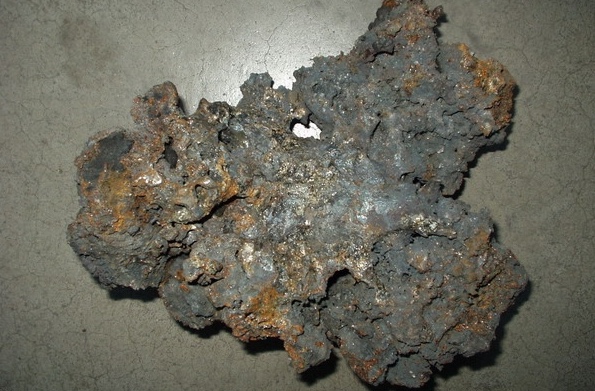
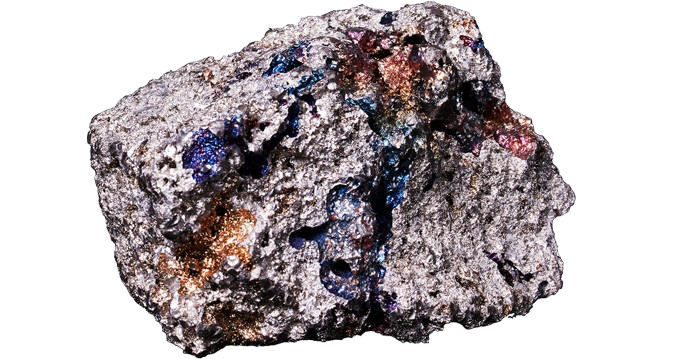
Tamahagane steel, also known as the purest steel in the world, is produced by Tatara-Seitetsu(たたら製鉄), an ancient Japanese iron-making process.
・たたら製鉄によって得られる
伝統的な製法 -Crafted by traditional methods-
Katana has its own manufacturing process, and one of the requirements for Real Katana is that it be made correctly according to this process. This is also a factor in the definition set forth by the Japanese government.
細かく分けると以下のようなプロセスになる。各工程について簡単に説明する。
■ 卸し鉄(おろしがね)
■ 水挫し(水減し/みずへし)
■ 小割り(こわり)
■ テコ棒とテコ台を作る
■ 積み重ね
■ 積み沸かし(つみわかし)
■ 鍛錬(たんれん)
▼ 下鍛え
▼ 上げ鍛え(あげきたえ)
■ 芯鉄を鍛える
■ 造り込み
■ 素延べ(すのべ)
■ 火造り
■ 切先つくり
■ 焼き入れ
■ 合い取り
■ 鍛冶研ぎ
■ 茎仕立てと銘切り
この工程に沿ってKatanaが作られているのか確認する方法はないが、実際にはものを見れば分かることである。
この工程によって地金が出て、この工程によって波紋が出る。本物かどうかは実物を見れば一目瞭然である。
分からなければ、日本刀に詳しい知人に確認をすることをお勧めする。
高い耐久性 -High durability-
The final requirement for Real Katana as defined by the country is its durability. The Agency for Cultural Affairs requires Real Katana to be able to withstand strong impacts without breaking or bending.
江戸時代にはこのようなテスト
現代ではユーチューバーがこんなテストを行なっている。
実施には耐久性をチェックする方法はないしする必要はない。前章で説明した伝統的な手法で作られている日本刀であれば、耐久性は間違いないので、実質的には耐久性は、製法に内包される条件と考えて良い。
高い切れ味 -High cutting ability-
From here on, beyond the definition designated by the government, these are the conditions generally used by Japanese experts in recognizing Real Katana. “Sharpness” is one of these factors.
上述した通り、過去には試し切りによって切れ味の検証がされ、それに応じたランクが存在してきた。
現代でもユーチューバーがこのような実験を行なっている。
実際に切れ味を検証することはできないので、確認の方法はない。ただし、歴史上の有名な投稿の作品であればその切れ味は保証されていて
刀工 ーName of the swordsmithー
The distinct name of the swordsmith who made the Katana is another requirement for forming a Real Katana.
名前のある刀工が作っている
過去の刀工であれば、このような一覧
現代の刀工であれば国のライセンスを受け、月に数本程度だけ作れるようになっている。
刀工の名前は、基本的に、なかごに掘られている。
これは重要な条件の一つ。ただし気をつけたいのが、実は名前が入ってなくても国宝に指定されているようなものや、出来栄えの非常に優れている刀はたくさんある。
逆に名前が入っていても、昔の人の誰かが入れたであろう明らかな偽物もある。日本の業者の中には、明らかに偽物だと分かっていてもそれを客に伝えずに本物として売る人もいる。
彫られた名前に加えて、やはり作品自体の出来栄えを十分に評価することがとにかく大切である。
刃文 ーHamonー
波紋が表現されている
金額 ーPriceー
一般的な値段や値付けのロジックも書いておく
~~~
~~~
3. 本物の古刀 ーWhat is Real Antique Katana?ー
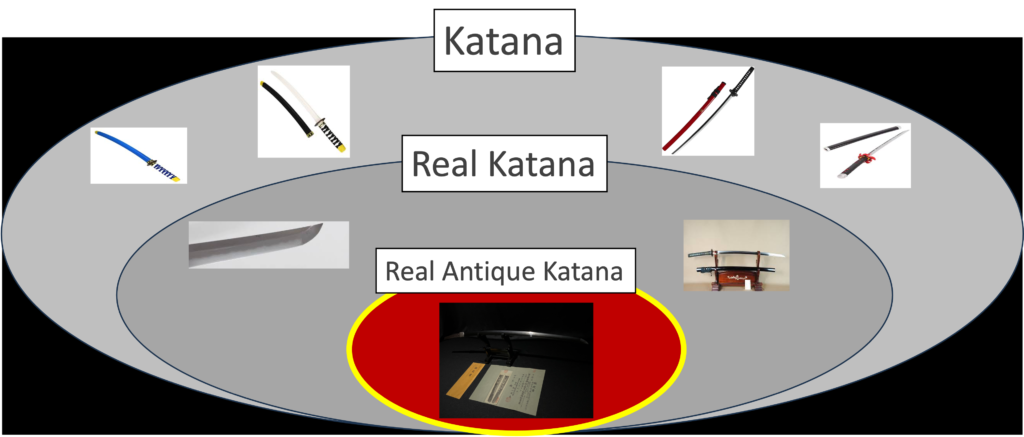

made in 1300-1850
室町から江戸にかけて作られたKatanaである
歴史的な価値を内包している
新たに作ることができないので数量が限られている!!
Tamahagane steel
玉鋼で作られている。
非常に難解な技術で、現代では再現不可能と言われている
現代では再現不可能な製法 -methods-
今では正確に再現することのできない過去の製法。
ベースはReal Katanaで説明した通りだが、そこのどこかの工程が違うことで再現ができない。
かずに限りがあると言われる所以。
過去の伝説の刀工達 -legendary Sword Smith-
かつての日本で活躍した様々な著名な歴史上の刀工によって作られている
作り手によって作風が違う。それを楽しむ。
五箇伝のルーツを持つ -Gokaden-
全てのアンティーク刀は五かでんに紐づけられる。由緒正しき、正規のルーツがある
武士が勢力を拡大するとともに日本刀の需要も高まり、古刀期には「五箇伝」(ごかでん)と呼ばれる5つの地域での伝法が確立されます。
それぞれの地域と時代で特色のある日本刀が作刀され、優れた刀工を数多く輩出。これらの名工達は現代でも高い人気を誇っています。
五箇伝はどの地域で繁栄し、どんな名工を生み出したのでしょうか。
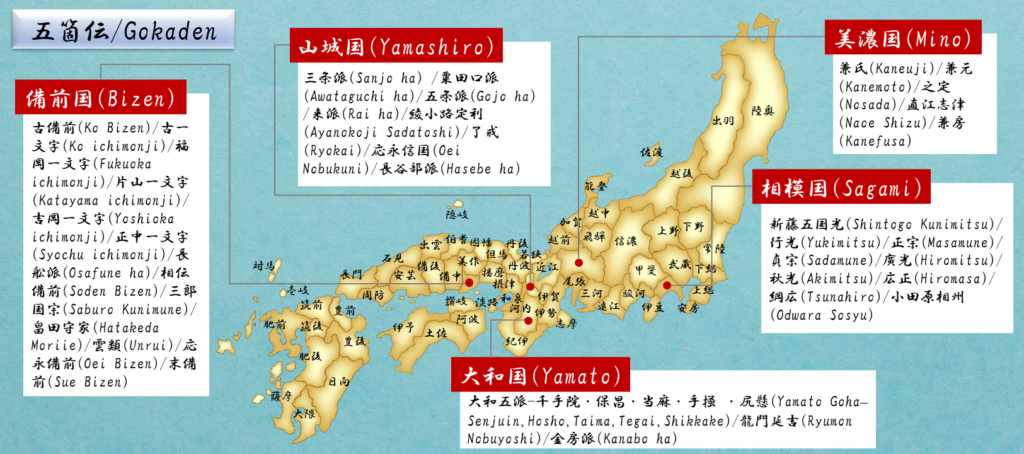
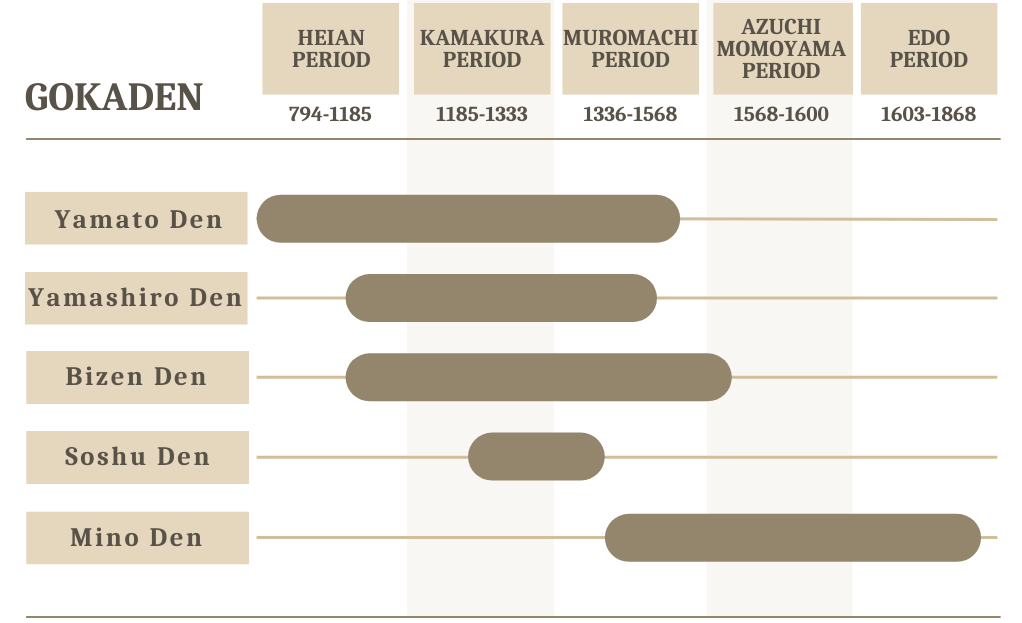
見分け方
Real Antique Katanは、どのように見分けるのか!
ここをよく見よう!!!という説明をみっっちり
金額 ーPriceー
一般的な値段や値付けのロジックも書いておく
~~~
~~~
